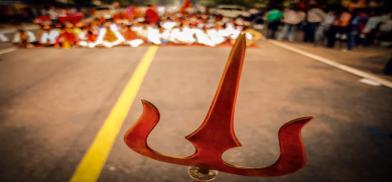Politics of polarization and attacks on syncretic traditions
The attack on syncretism from multiple directions and the communal distraction in the face of the worsening plight of people should worry us all

India’s cultural and religious richness lies in its diversity. Many poets and writers have given a beautiful picture of different caravans coming here, interacting and creating a lovely bouquet of our cultural interactions. The peak of this was during freedom movement when people from diverse communities interacted to get rid of colonial yoke. At the same time, some opposing sectarian processes also developed and they tried to retard this process, which peaked in the partition of the country.
With freedom, we saw the interaction and syncretism being the main process while divisive tendencies were weak and marginal. During last four decades, these sectarian tendencies are raising their ugly head and opposing the Indian diversity very strongly. Recent weeks saw this in a very disturbing way.
A maulana of a minor madarassa in Deoband passed a fatwa against Farzani Naaz, a Muslim singer whose bhajan (Hindu devotional song) ‘Har Har Shambho’, became a hit. This maulana is a favorite of TV channels who in their prime time ‘cock fights’, mistakenly called debates, pitch the extreme elements from both religions and reap the rich harvest of TRP. Incidentally this maulana has nothing to do with Darul Ulum Deoband, the main madrassa, which gives fatwa when someone asks for it. Fatwa as such means an opinion.
Fake maulana
This retrograde Maulana Asad Kasmi is totally ignorant of the great tradition of Hindu bhajan singers starting from Mohammad Rafi to Faraz Khan, whose songs are sort of immortal contribution to Hindu devotions songs. Many of these are composed by outstanding music directors like Naushad Ali to A.R. Rahman. The list can fill pages but I am tempted to cite just two of them.
My biggest favourite is Man ‘Tarpat Hari Darshan ko Aaj’ (Sung by Rafi, composed by Naushad Ali and written by Shakil Badayuni). Who can forget the bhajan ‘Hari Om Tatsat’, sung by none other than Bade Ghulam Ali Khan? It is not a one way traffic; there are many remarkable Hindu singers who have contributed to the singing of qwwali, Prabha Bharati and Dhruv Sangari being the foremost among them.
One recalls a few years ago, a Bengali film actor and MP, Nusrat Jahan, was hauled by these clerics for participating in a Durga Puja, something which is part of Bengali culture. Across the border, a Muslim college teacher was harassed by the police for wearing a Bindi, saying it is a Hindu practice. It is good that the policeman was suspended.
Rumour mills
Systematically rumors are spread as to how mosques store weaponry, used in communal violence. There are also horrid rumours that Hindus can’t enter masjids (mosques). The contrary is true that many Hindu temples don’t permit people of other faith. As far as masjids are concerned there is no such prohibition.
In a society like ours, where segregations have increased, some schools have started field trips for their students to different places of worship. Now, while some of these go on well. there seems to be a rising opposition to such events from the likes of Bajrang Dal.
Delhi Public School in Vadodara, as a part of exposing children to diverse places of worship, planned to take the children to a trip to a mosque. The Bajrang Dal warned of dire consequences and the trip had to be called off. Earlier, these children were taken to a temple. Similar incidents are reported from Delhi and Karnataka among others.
These attacks on our syncretism are becoming more in intensity as the polarization politics is becoming the order of the day.
Polarizing politics
One of the shocking examples of this polarizing politics was witnessed recently when the Indian National Congress decided to organize a protest at Parliament House to march to Rashtrapati Bhavan against rising prices, GST and other pressing issues. They wore black clothes as a symbol of protest.
The BJP, true to its character, used this protest to deepen its polarizing agenda. Amit Shah, the top leader of BJP and the Home Minister, stated that the Congress is trying to oppose the Ram Temple in Ayodhaya as the protest took place on August 5, the day Modi inaugurated the construction of the Ram temple. He was joined by Uttar Pradesh Chief Minister Yogi Adityanath who asked the Congress to apologize for “insulting” Ram devotees.
Convert everything to Religion, emotive issues and deepen the communal divide – this trend is increasing. Can other opposition parties and social movements take on the sectarian twists of BJP? Can the democratic and secular elements, groups and parties swallow such gross distraction from people’s problems?
BJP, supported by its collaborating organizations and compliant media in tow, is pursuing an agenda where people’s problems have no place. What matters is rousing the emotive pitch around religious and nationalist issues to pursue a deeper agenda.
The attack on syncretism from multiple directions and the communal distraction in the face of the worsening plight of people should worry us all. The democratic narrative where people’s problems should be at the forefront needs to be boosted with full energy.
(The writer, a former IIT Bombay professor, is Chairman, Center for Study of Society and Secularism, Mumbai. Views are personal.)









Post a Comment